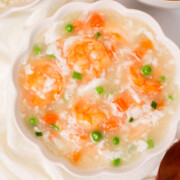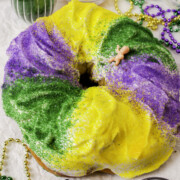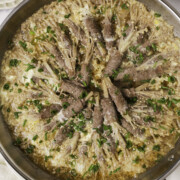Vietnamese pickled carrots and daikon, or đồ chua, is a must-have side that you'd find stuffed inside of banh mi or paired with other Vietnamese dishes like bún thịt nướng (grilled pork vermicelli). They are super easy to make and takes only 15 minutes of active prep time!

If you love Vietnamese food, you probably know and love đồ chua! We love a generous portion of đồ chua in our bún thịt nướng (aka Vietnamese grilled pork vermicelli) for some sweet and tangy crunch, or with Vietnamese fried egg rolls (chả giò) wrapped in some lettuce.
It's such a versatile side dish and goes well with so many Vietnamese dishes!
Also check out our oi kimchi (quick cucumber kimchi) and Chinese smashed cucumber salad if you're looking for more crunchy, refreshing side dish ideas!
Jump to:
What is đồ chua?
Đồ chua literally translates to pickles. We most commonly associate and know it as the Vietnamese pickled carrots and daikon radish. It's less acidic and a bit sweeter than our average pickles. You'll find đồ chua as a side with almost any Vietnamese meals and dishes.

Ingredients
Please scroll down to the recipe card for the ingredient quantities!
- Daikon radish - The real star of this Vietnamese pickle that brings out the iconic đồ chua flavor! You can usually find daikon radish at any Asian markets.
- Carrot - You can use equal amounts of carrots to daikon radish. We prefer more daikon over carrot, so adjust as you wish!
- Salt - To salt the carrots and radish so that excess moisture can be removed. It makes the pickles crunchier.
- Water - To dilute the pickling liquid so that the flavor is more balanced. We recommend using filtered, boiled, or distilled water to ensure that the water is as clean as possible.
- Sugar - For sweetening the pickling liquid. Just regular granulated sugar will do.
- White distilled vinegar - This is the acid for the pickling liquid. If you don't have white distilled vinegar, you could use rice vinegar too.

How to make đồ chua
1. Using a mandolin, cut the daikon radish and carrots into thin, matchstick strips (aka julienne). You can also julienne the vegetables by hand.
🚨 Caution! Mandolin blades are very sharp and is known as the "finger guillotine" in restaurant kitchens. Gory, I know. So please be careful when using one! Also, you can cut the veggies into 2 inch chunks so that you can use the mandolin guard.
2. In a bowl, toss together the julienned radish, carrot, and salt until evenly coated. Let it sit for 3 to 5 minutes to extract excess moisture.
3. While waiting, make the pickling liquid by combining the water, sugar, and vinegar in a saucepan. Heat until the sugar completely dissolves, stirring occasionally. Remove from heat.

🌟 Pro tip: If you prefer, you can microwave the pickling liquid or use hot water to dissolve the sugar.
4. The radish and carrot should be ready at this point. Rinse with fresh water and drain well. Also, gently squeeze the vegetables to get rid of excess moisture. Personally, I like to fluff up the veggies again so that they are not clumped together.
5. Divide the radish and carrots amongst two sterilized 16 ounce jars. Evenly pour the prepared pickling liquid into the jars, making sure the vegetables are fully submerged.
6. Leave the pickled vegetables to cool completely before capping. Let it pickle at room temperature for up to 24 hours, or until they are pickled to your taste. Then, keep them refrigerated for up to 4 to 6 weeks.

How to sterilize glass jars
The easiest way to sterilize your glass jars or canning jars for these pickled carrots and radish is by boiling them. Just bring a pot of water to a boil and gently submerge your jars into the water completely. Let them boil for 10 minutes for altitudes of 1000 feet or less and add an additional minute per 1000 feet.
Once they are done boiling, carefully remove the jars and let them cool completely before using.
Recipe tips
- Adjust the ratio of carrots to daikon radish to your preference. Just note that the pickling liquid is meant for 1 ½ pounds of vegetables.
- The thickness of the vegetables determine how long it'll take for the carrots and radish to become pickled (ie. the thicker, the longer time needed).
- Sterilize the jars so that they are absolutely clean. This will ensure your pickles don't go bad and ferment properly.

Storage
The pickled carrots and daikon radish will stay good in the fridge for up to 4 to 6 weeks. Do note that as the pickles sit, the flavor will become more acidic due to the fermentation.
FAQ
We do not recommend reducing the amount of sugar used, as it plays a big part in how the đồ chua will taste. If you do reduce the sugar, just keep in mind that the flavor will not be the same and more than likely will be more acidic.
We prefer using just regular white distilled vinegar. The flavor is clean and it's very affordable. If you prefer, you could use rice vinegar as a substitute.
That is totally normal! The smell is from the daikon radish. Especially when daikon radish gets cooked or fermented, the smell becomes much more pungent. The smell is iconic to these Vietnamese pickles.
If you’ve made this recipe or any recipes from our blog, please tag us on Instagram using #twoplaidaprons! You can also tag us in your Instagram stories using @two_plaid_aprons. We would love to see your creations! It absolutely makes our day! 🥰
📖 Recipe
Vietnamese Pickled Carrots and Daikon (Đồ Chua)
Ingredients
- 1 pound daikon radish peeled (about ½ of a large one)
- ½ pound carrot peeled (usually 1 large carrot)
- 2 teaspoons Kosher salt or fine salt
- 1 cup water
- ⅔ cups granulated sugar
- ½ cup white vinegar
Instructions
- Using a mandolin, cut the daikon radish and carrots into thin, matchstick strips (aka julienne). Be very careful! The mandolin is very sharp! You can also julienne the vegetables by hand.
- In a bowl, toss together the julienned radish, carrot, and salt until evenly coated. Let it sit for 3 to 5 minutes to extract excess moisture.
- While waiting, make the pickling liquid by combining the water, sugar, and vinegar in a saucepan . Heat until the sugar completely dissolves, stirring occasionally. Remove from heat.
- The radish and carrot should be ready at this point. Rinse with fresh water and drain well. Also, gently squeeze the vegetables to get rid of excess moisture.
- Divide the radish and carrots amongst two sterilized 16 ounce jars. Evenly pour the prepared pickling liquid into the jars, making sure the vegetables are fully submerged.
- Leave the pickled vegetables to cool completely before capping. Let it pickle at room temperature for up to 24 hours, or until they are pickled to your taste. Then, keep them refrigerated for up to 4 to 6 weeks.
Notes
- Feel free to multiply the recipe is you want to make a bigger batch!
- If this is your first time having do chua, note that it will be a little pungent. The smell is attributed by the daikon radish.
- Ratio of daikon radish to carrots - This is really up to your preference. We prefer more daikon over carrots, but you can totally use more carrots instead. The pickling liquid is perfect for 1.5 pounds of veggies, so adjust as needed.
- It's best to use filtered, boiled, or distilled water to ensure that your pickles ferment properly.






















Comments
No Comments